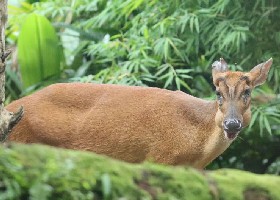Muntjac Deer Muntiacus reevesi


The Muntjac is Britain's smallest common deer. It is an Asian deer, from China, Taiwan and Japan, escaped from captivity
(from Woburn) and quickly colonising parts of the country. It is similar in size to the Chinese Water Deer
(both about 20 inches high at the shoulder) which is also feral in more limited parts of the UK.
There are several species of Muntjac in the wild in Asia, including the Red Muntjacs, previously lumped together as the Common or Indian
Muntjac, Muntiacus muntjak (link below).

 The buck (male) has small antlers, re-grown each year.
The buck (male) has small antlers, re-grown each year.

The buck above is losing the initial "velvet" protective skin on his antlers (the gaping mouth is because he's eating a large crab apple fallen from a tree).



The buck (male), above, has fully-grown antlers and is showing the long, downward-pointing canine tooth or tusk also used for defence.



The doe (female), above, has no antlers. (Male and female smaller deer are generally called Buck and Doe, like rabbits;
larger deer are called Stag and Hind.)
 A pair.
A pair.
 Size comparison: Fallow Deer and Muntjac.
Size comparison: Fallow Deer and Muntjac.
 Usual view of a Muntjac disappearing, tail up in alarm.
Usual view of a Muntjac disappearing, tail up in alarm.
Due to its tropical origins, the Muntjac reproduces at any time of year even in a temperate climate. However, it does,
in the UK at least, have a thicker, winter brown/brown-grey coat and a sleeker, redder brown summer coat.



